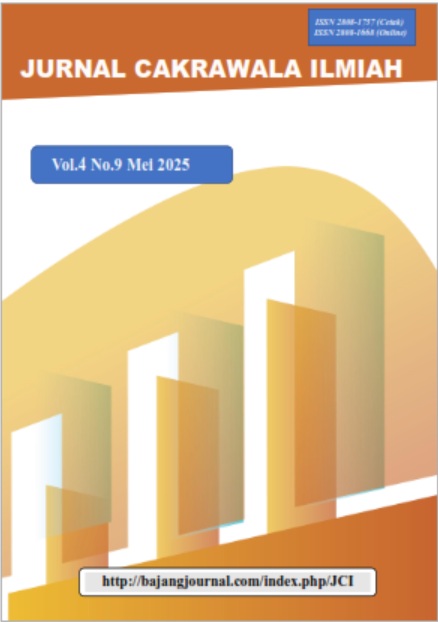PENGARUH PENGGUNAAN METODE JOLLY PONICS DENGAN MODEL KOPERATIF TERHADAP KEMAMPUAN MEMBACA PADA SISWA KELAS II SD NEGERI 101931 PERBAUNGAN
Keywords:
Jolly Phonics Method,, Students' Reading Ability.Abstract
The Jolly Phonics method is a way of teaching reading by using letter sound synthesis to read words and teaching the sounds of letters in a multisensory manner. Learning to read at an early stage using a phonics approach is a very good first step for children. Children who hear a variety of sounds in words and who are able to use the sounds in words are more successful in learning to read. This research aims to analyze the effect of using the Jolly Ponics method with a cooperative model on the reading ability of class II students at SD Negeri 101931 Perbaungan. The research uses quantitative research. This study used research instruments in the form of a pretest and posttest to test the effect of using the jolly ponics method with a cooperative model on reading ability in class II students at SD Negeri 101931 Perbaungan. Based on the research results and discussions that have been found, the researcher can draw the conclusion that the simple linear regression equation from this research is: Y = 11.575 + 0.414X. The constant value (a) is 11.575. This means that if the Jolly Ponics Method variable (X) has a value of 0, then the value is positive, namely 11,575. The regression coefficient value for the Jolly Ponics Method variable (X) is positive, namely 0.414. This means that if there is an increase in the Jolly Ponics Method (X) by 1%, then students' reading ability will increase by 0.414 assuming other variables are constant. There is a positive influence between the jolly ponics method on the reading ability of class II students at SD Negeri 101931 Perbaungan, this is proven by the t-count value of the jolly ponics method variable of 2.358
References
Dinda Yarshal. 2015. Penerapan Model Problem Based Learning (PBL) Dalam Meningkatkan Aktivitas dan Hasil Belajar PPKn Pada Siswa Kelas IV MIN Medan Tahun 2014/2015. Jurnal TEMATIK. Program Studi Pendidikan Pascasarjana UNIMED Vol.5 No. 1.
Hidayat dan S. Khayroiyah. 2018. Pengembangan Desain Didaktis Pada Pembelajaran Geometri. Jurnal MathEducation Nusantara Vol. 1 (1), 2018, 15-19. https://jurnalpascaumnaw.ac.id/index.php/JMN/article/view/2/2
Johnston, R. & Watson, J. (2018) The Effects Of Synthetic Phonics Teaching Of Reading And Spelling Attainment: A Seven Year Longitudinal Study. Available online at: http://www.scotland.gov.uk/ Resource/Doc/36496/0023582.pdf
Karina & Sujarwo. 2023. Pengembangan E-LKPD Interaktif Berbasis Masalah Pada Materi Penyajian Data dalam Bentuk Diagram Batang. Jurnal Penelitian Pendidikan MIPA (JP2MIPA) Volume 7 Nomor 2. https://jurnal-lp2m.umnaw.ac.id/index.php/JP2MIPA/article/view/1849
Rangkuti, C. J. S., & Sukmawarti. 2022. Problematika Pemberian tugas Matematika Dalam Pembelajaran Daring. IRJE Jurnal Ilmu Pendidikan, 2(2), 565-572.
Ria Alda & Hasanah. 2023. Analisis Model Project Based Learning Terhadap Kreativitas Siswa Pada Tema Benda-Benda di Sekitar Kita di Kelas V SD Negeri 067092 Medan. Jurnal Inovasi Penelitian Vol. 3 No. 9.
Seefeldt, C., & Wasik, B. A. (2018). Pendidikan anak usia dini menyiapkan anak usia tiga, empat, dan lima tahun masuk sekolah. Jakarta: Indeks.
Stuart, M. (2016). Getting Ready for Reading: Early Phoneme Awareness and Phonics Teaching Impoves Reading and Spelling in Inner-City Second Language Learners. British Journal of Educational Psychology. 69. 587-605.
Sugiyono. 2018. Metode Penelitian Kuantitatif, Kualitatif, Dan R&D. Bandung: Alfabeta CV.
Sukmawarti, Hidayat, & Suwanto. 2021. Desain Lembar Aktivitas Siswa Berbasis Problem Posing Pada Pembelajaran Metematika SD. Jurnal Matheducation Nusantara, 4(1), 10–18. https://jurnal.pascaumnaw.ac.id/index.php/JMN/article/viewFile/118/104
Sukmawarti, Hidayat, Lili Amelia Putri. 2022. Workshop Worksheet Berbasis Budaya bagi Guru MI Jami’atul Qamar Tanjung Morawa. PaKMas: Jurnal Pengabdian Kepada Masyarakat, 2(1), Hal : 202-207. https://doi.org/10.54259/pakmas.v2i1.848
Downloads
Published
How to Cite
Issue
Section
License
Copyright (c) 2025 Jurnal Cakrawala Ilmiah

This work is licensed under a Creative Commons Attribution-NonCommercial 4.0 International License.
















